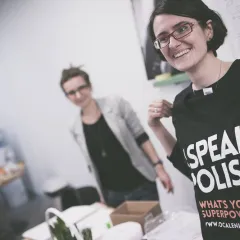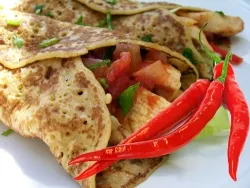Less than one month ago, as I sat with a Mexican friend in her kitchen, we talked about the difficulty of finding decent tortillas outside of the Americas. It happened to me ten years ago when I was visiting friends in Switzerland and they wanted me to cook Mexican food for them, and it still happens to me in Poland today. Thanks to my discriminating taste, I cannot stand the Tortilla made in Europe. This led me to wonder if it is really possible to find 'Sabor Mexicano' outside of Mexico. And I don’t mean the Tex-Mex kind of food people are likely to find all over the world in so called Mexican restaurants, disasters made out of corn chips, jalapeño peppers and olives, all drowning under a layer of oily melted yellow cheese and perhaps some dehydrated sour cream. For whomever has tried this “Mexican Bomb,” then fallen victim of Moctezuma’s Revenge, I must clarify that the only Mexican thing about this culinary assault is its name —Nacho is short for Ignacio, so stay away from nachos, especially at the cinema, if you want to know how the film ends.
Determined to plagiarize resources, I went and talked with Chef Mauricio Blanco at Taqueria Mexicana to discuss ingredients, steal recipes, and reminisce about life in Mexico. A graduate of the Gastronomy School in San Angel, Mexico, Mauricio has been in the restaurant business for twenty years, five of which he has spent in Warsaw. A rarity amongst Mexicans in Poland, it was not a woman what brought him here, but a restaurant.
“Now tell me, where do you find the ingredients you need to cook the more specialized dishes in your menu?” I asked.
“All over Europe! There is a big importer of Mexican goods in Germany. Whatever I cannot find there or in Spain, I order directly from a Mexican importer based in Warsaw, which I try not to do too often because of the sheer size of the order I must place with this wholesaler. He handles shipments by the ton, so you can’t go little with him.”
“And the tortillas, where do you get them from?”
“From the Czech Republic, where they are fairly decent, made with authentic Mexican machinery brought to Europe by an American entrepreneur who supplies restaurants in Eastern Europe. Regrettably, because of the sudden price increase of corn, I had to stop making tortillas in the restaurant,” he said sadly.
“This is very bad news for the authentic Mexican food lover.”
“I’ll tell you what,” he said in a conspiratorial manner. “Whenever you come here, if you want me to cook something special for you, just say the word and I’ll do it. Members of the Mexican community in Warsaw ask me to make them sopes (a thick, fried corn masa cake topped with fried beans, ground meat, crumbled cheese and salsa), molotes, gorditas, flautas, and quesadillas fritas.”
“Well, I’ve been dying for a bean burrito the past couple of days . . .” I said hopefully.
“No, don’t ask me for beans today. I ran out of beans and my supplier hasn’t been able to send me a new shipment. How about some flautas?”
What could I do but have the flautas? (known as rolled tacos in the United States). I found them to be quite good despite the fugitive beans. I also sampled three of Mauricio’s home-made salsas, a green, sweet one made with kiwi which I found to have Oriental overtones, a spicy one made with chile ancho, and a hot one which he makes using red chillies.
Of course his Mole Poblano is to die for, and a very pleasant surprise when I was ready to declare Warsaw a culinary desert for the Mexican gourmet. Being mole a rather difficult sauce to prepare, as it is made with approximately 100 ingredients, trying something so tasty so far from home came as a very pleasant surprise.
Described as a chocolate-chili sauce, mole is that and much more. The good news is, mole can be purchased in the form of a dark brown paste from suppliers, which is what Mauricio does, but then he goes and adds even more ingredients to the original —toasted sesame seeds, garlic, more chile, all blended in consommé to give it his own personal signature. It is then served with chicken over a bed of rice or with fried eggs and beans. A true delicacy for the food connoisseur.
I’m determined to visit Mauricio again to satisfy my bean burrito craving, though I’m really thinking about a plate of chilaquiles en salsa roja con huevos fritos montados too (fried tortilla strips in red chili sauce topped with two fried eggs and a side of refried beans), a breakfast staple in Mexico and an excellent cure for a hangover. That, and some café de olla (ground coffee and cinnamon sticks boiled together in an earthenware pot) should hit the spot.
America L. Martin













